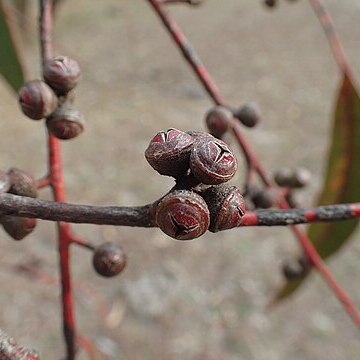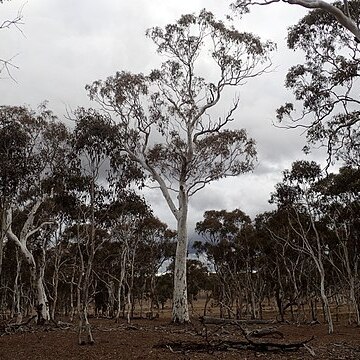Tree to 20 m tall. Forming a lignotuber. Bark smooth, usually powdery, white with yellow, orange or grey patches, horizontal black scars sometimes present on trunk. Juvenile growth (coppice or field seedlings to 50 cm): stem rounded in cross-section, glaucous; juvenile leaves opposite, sessile for many pairs, becoming alternate and petiolate in late juvenile phase, orbicular at first then ovate to elliptical, 2–10 cm long, 2–6 cm wide, blue-green or glaucous.Adult leaves alternate, petiole 0.9–4.5 cm long; blade lanceolate to falcate, 7–20 cm long, 1.3–3 cm wide, base tapering to petiole, concolorous, glossy or dull, green to blue-green, side-veins greater than 45° to midrib, densely to very densely reticulate, intramarginal vein parallel to and remote from margin, oil glands island or intersectional.Inflorescence axillary unbranched, peduncles 0.4–1.7 cm long, buds 7 per umbel, pedicels 0.1–0.5 cm long. Mature buds ovoid, 0.5–0.8 cm long, 0.3–0.4 cm wide, green to yellow, sometimes glaucous, scar present, operculum conical, stamens irregularly flexed, anthers cuboid or cuneate, versatile, dorsifixed, dehiscing by longitudinal slits (non-confluent), style long, stigma blunt, locules 3 or 4, the placentae each with 4 vertical ovule rows. Flowers white.Fruit pedicellate (pedicels 0.1–0.4 cm long), cup-shaped or hemispherical, 0.4–0.6 cm long, 0.5–0.8 cm wide, disc raised convex or oblique, valves 3 or 4, exserted.Seeds brown, black or grey, 1–2.1 mm long, ovoid or flattened-ovoid, often pointed at one end, lacunose, dorsal surface smooth or shallowly pitted, hilum ventral. Cultivated seedlings (measured at ca node 10): cotyledons bilobed to oblong; stems rounded in cross-section, smooth to slightly warty, glaucous; leaves sessile and opposite for at least 17 nodes, ovate or cordate, 5–7.5 cm long, 3–4.5 cm wide, lower leaves amplexicaul but becoming rounded up stem, margin entire, apex pointed, dull, blue-green to grey-green (new growing tips waxy but wax not persisting on expanded leaves).
More
Tree to 20 m. Juvenile leaves orbicular or ovate to broadly lanceolate, subglaucous, concolorous. Adult leaves lanceolate; lamina 15–25 cm long, 1.5–3 cm wide, green; petiole 15–27 mm long. Peduncle 5–10 mm long; pedicels 1–3 mm long. Buds glaucous; operculum hemispherical to conical, 2–4 mm long, 3–4 mm wide; hypanthium hemispherical, 2–3 mm long, 3–4 mm wide. Fruits hemispherical to subglobular, 5–7 mm long and wide; disc convex or ascending.


